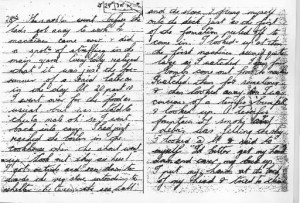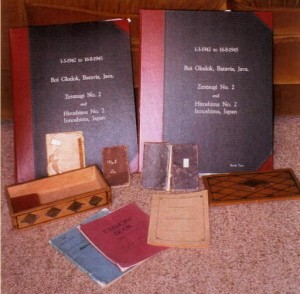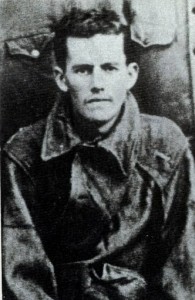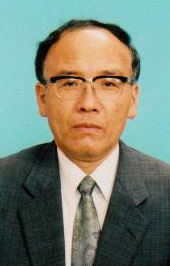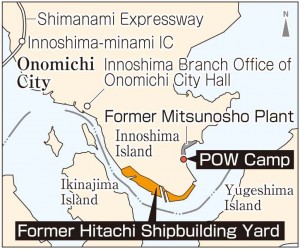British POW leaves diary that describes air raid on local island
Jul. 28, 2015
by Kyoko Niiyama, Staff Writer
A devastating air raid on Innoshima Island, off the city of Onomichi in Hiroshima Prefecture, on July 28, 1945 was described in detail by a British POW who kept a diary while held in a prisoner-of-war camp on the island. Following the end of World War II, the man returned to the United Kingdom. In 1998, he visited the island and the site of the former POW camp. At the time, he entrusted a copy of his diary to Koshi Kobayashi, 75, a resident of Fukuyama, Hiroshima Prefecture, who was serving as a guide, and asked Mr. Kobayashi to “convey these facts to future generations.” The man, Tom Jackson, passed away in 2012 at the age of 89. Tetsu Fukubayashi, a resident of Kyoto Prefecture and a co-founder of the POW Research Network Japan, a citizens’ group that has been researching the reality of prisoners of war in Japan, said, “Since detailed writings by POWs are rare, this is valuable material.”
Mr. Jackson was from York, England. An airman in the Royal Air Force during the war, he was captured on the island of Java by Japanese soldiers.
In his diary, he describes the tense time when Innoshima was attacked: “I saw four bombs come out from the machine. I watched them for some time and then looked away. I was conscious of a terrific ‘bump’ and looked up. A terrific fountain of smoke and debris was filling the sky. I l0oked at it and said to myself ‘I’d better get my head down and cover my back up.’”
He continued to explain: “For about half an hour the machines were diving, bombing and strafing. Watanabe’s house received a direct hit and two kiddies were killed somewhere in the houses, about five houses were completely wiped out of existence.”
He also noted, “The only casualty amongst the prisoners was Charlie Manson who received some shrapnel in his left arm,” revealing that prisoners suffered in the air raid, too.
The POW camp was established in November 1942 as the Innoshima Branch of the Yahata Prisoner-Of-War Camp. About 200 prisoners were engaged in such tasks as repairing ships at the island’s old Hitachi Shipbuilding Yard until September 1945.
That day, workers at the shipyard, as well as residents of the island in that area, were affected by the air raid, but the number of casualties has not been confirmed. A British writer who was also in the camp later wrote about his daily life there in one of his books, stating, “So far as casualties were concerned, these were put at four hundred (including one hundred and sixty killed) not one of which was a prisoner.”
Mr. Jackson visited the former camp in November 1998 and met residents he had known from the time he was a POW. He gave such materials as a copy of the diary he kept during the war, copies of drawings which depicted life at the camp, and some original photos to Mr. Kobayashi. Mr. Kobayashi served as Mr. Jackson’s guide when former POWs were invited to Japan.
According to Mr. Kobayashi, Mr. Jackson told him, “We were tormented by the Japanese and I felt bitter. But my hate disappeared when I could interact personally with the local people and learned how much they value peace.” Mr. Jackson asked Mr. Kobayashi to use the materials to tell future generations about the tragic consequences of the air raid.
Mr. Fukubayashi explained, “It’s rare to find descriptions of air raids in diaries kept by POWs. His materials are important for helping to clarify the actual conditions of the Innoshima Air Raid.” He said he hopes to use these materials to convey the importance of peace.
(Originally published on July 18, 2015)
A devastating air raid on Innoshima Island, off the city of Onomichi in Hiroshima Prefecture, on July 28, 1945 was described in detail by a British POW who kept a diary while held in a prisoner-of-war camp on the island. Following the end of World War II, the man returned to the United Kingdom. In 1998, he visited the island and the site of the former POW camp. At the time, he entrusted a copy of his diary to Koshi Kobayashi, 75, a resident of Fukuyama, Hiroshima Prefecture, who was serving as a guide, and asked Mr. Kobayashi to “convey these facts to future generations.” The man, Tom Jackson, passed away in 2012 at the age of 89. Tetsu Fukubayashi, a resident of Kyoto Prefecture and a co-founder of the POW Research Network Japan, a citizens’ group that has been researching the reality of prisoners of war in Japan, said, “Since detailed writings by POWs are rare, this is valuable material.”
Mr. Jackson was from York, England. An airman in the Royal Air Force during the war, he was captured on the island of Java by Japanese soldiers.
In his diary, he describes the tense time when Innoshima was attacked: “I saw four bombs come out from the machine. I watched them for some time and then looked away. I was conscious of a terrific ‘bump’ and looked up. A terrific fountain of smoke and debris was filling the sky. I l0oked at it and said to myself ‘I’d better get my head down and cover my back up.’”
He continued to explain: “For about half an hour the machines were diving, bombing and strafing. Watanabe’s house received a direct hit and two kiddies were killed somewhere in the houses, about five houses were completely wiped out of existence.”
He also noted, “The only casualty amongst the prisoners was Charlie Manson who received some shrapnel in his left arm,” revealing that prisoners suffered in the air raid, too.
The POW camp was established in November 1942 as the Innoshima Branch of the Yahata Prisoner-Of-War Camp. About 200 prisoners were engaged in such tasks as repairing ships at the island’s old Hitachi Shipbuilding Yard until September 1945.
That day, workers at the shipyard, as well as residents of the island in that area, were affected by the air raid, but the number of casualties has not been confirmed. A British writer who was also in the camp later wrote about his daily life there in one of his books, stating, “So far as casualties were concerned, these were put at four hundred (including one hundred and sixty killed) not one of which was a prisoner.”
Mr. Jackson visited the former camp in November 1998 and met residents he had known from the time he was a POW. He gave such materials as a copy of the diary he kept during the war, copies of drawings which depicted life at the camp, and some original photos to Mr. Kobayashi. Mr. Kobayashi served as Mr. Jackson’s guide when former POWs were invited to Japan.
According to Mr. Kobayashi, Mr. Jackson told him, “We were tormented by the Japanese and I felt bitter. But my hate disappeared when I could interact personally with the local people and learned how much they value peace.” Mr. Jackson asked Mr. Kobayashi to use the materials to tell future generations about the tragic consequences of the air raid.
Mr. Fukubayashi explained, “It’s rare to find descriptions of air raids in diaries kept by POWs. His materials are important for helping to clarify the actual conditions of the Innoshima Air Raid.” He said he hopes to use these materials to convey the importance of peace.
(Originally published on July 18, 2015)

